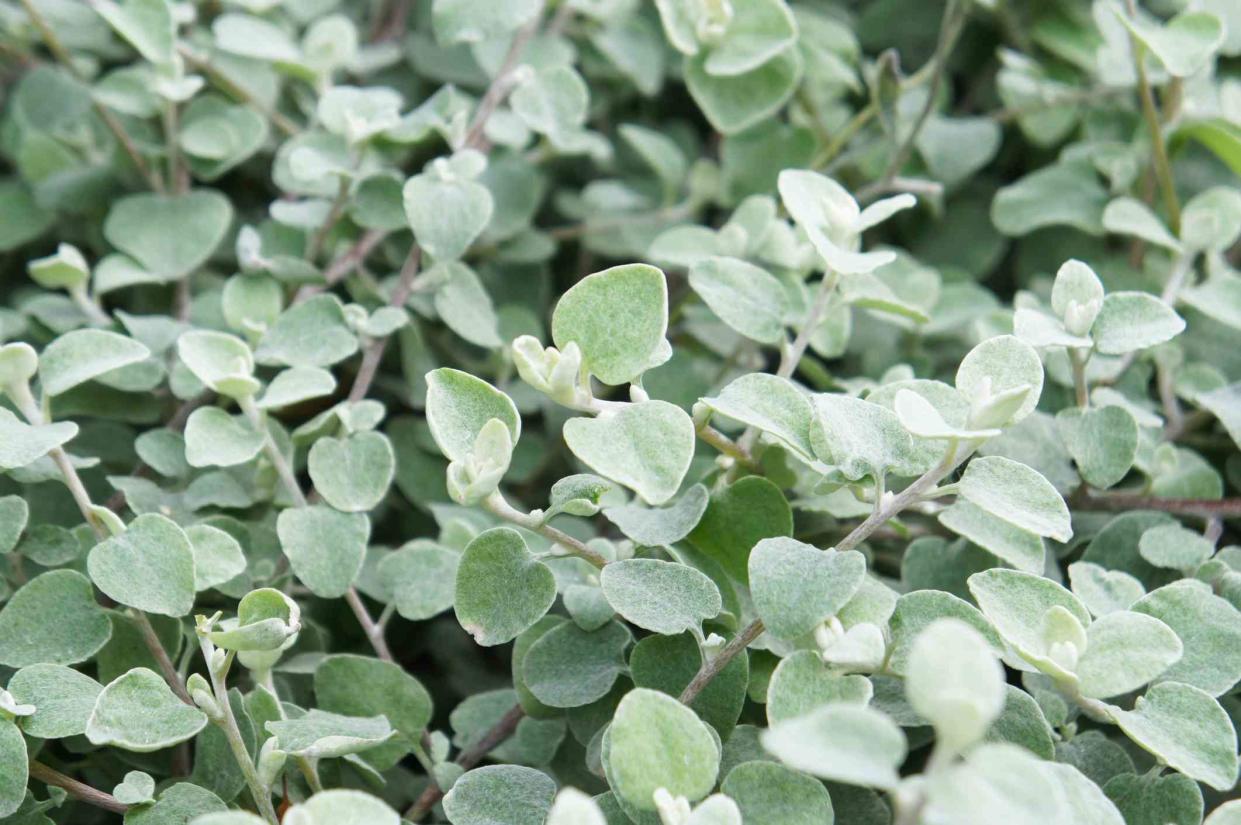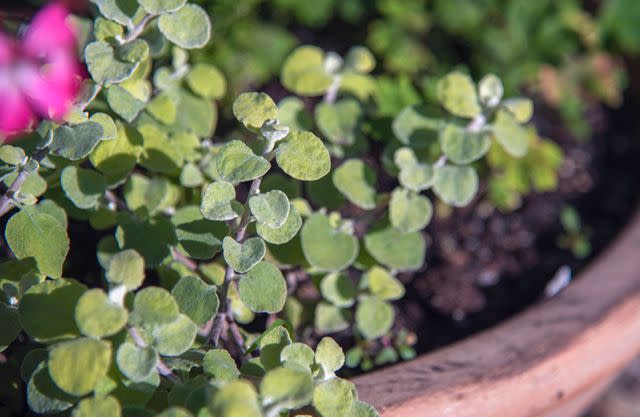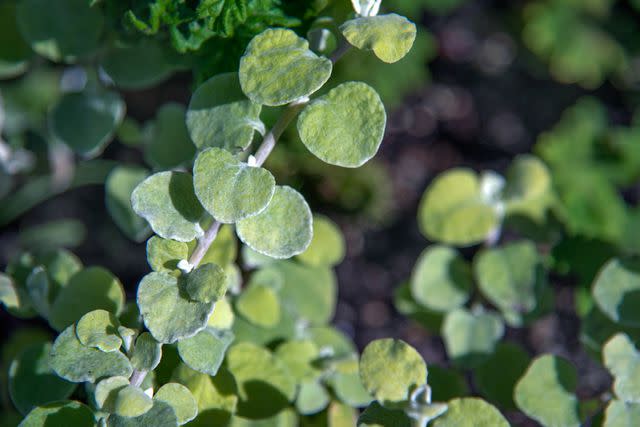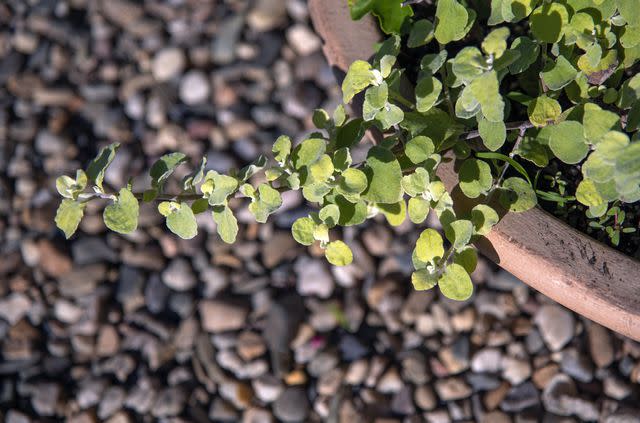How to Grow and Care for Licorice Plants Like a Pro

skymoon13 / Getty Images
Consider the liquorice plant when you’re looking for an easy-to-grow species for spilling out of containers or using as an attractive ground cover. The vigorous, compact shrub's silvery-gray, wooly, aromatic, trailing foliage stands out year-round, and the stalks of insignificant creamy-yellow flowers attract pollinators.
This warm-zone, drought-tolerant shrub thrives in a sunny spot with well-draining soil.
Common Name | Licorice plant, Herbal helichrysum |
Botanical Name | Helichrysum petiolare, syn. Helichrysum petiolatum |
Family | Asteraceae |
Plant Type | Shrub, Evergreen, Perennial |
Mature Size | Up to 2 ft. tall and 4 ft. wide |
Sun Exposure | Full, Partial |
Soil Type | Moist, Well-drained |
Soil pH | Acid, Neutral, Alkaline |
Bloom Time | Summer, Fall |
Flower Color | Cream, Yellow |
Hardiness Zones | 9-11 (USDA) |
Native Area | South Africa |

The Spruce / Evgeniya Vlasova

The Spruce / Evgeniya Vlasova

The Spruce / Evgeniya Vlasova
Licorice Plant Care
Here is a summary of the care requirements for licorice plants:
Plant in well-draining soil.
Position in full sun or partial shade (when the afternoon sun is particularly intense).
Water to keep evenly moist, but never let the soil get soggy.
Avoid high-humidity environments.
Amend soil with organic matter.
Want more gardening tips? Sign up for our free gardening newsletter for our best-growing tips, troubleshooting hacks, and more!
Light
Licorice plants are light lovers and typically do best in a full sun position, where they receive at least six hours of sun per day. A partial shade position might be appreciated when the afternoon sun is particularly intense.
However, insufficient access to light can result in weaker growth, and the silver foliage coloring won’t be so distinct.
Soil
A well-drained soil is crucial for your licorice plants, and for most vigorous growth, they prefer it to be fertile. However, these plants can handle poor soils, provided they aren’t prone to becoming waterlogged—soggy soils commonly lead to root rot.
Water
Established licorice plants, with their reflective, hairy foliage, are drought tolerant and can go a few months without water. This makes them an ideal choice for water-wise landscapes.
However, this species prefers evenly moist soil to see the most vigorous growth and to prevent leaf scorch on the striking foliage. This might mean watering around every two to three weeks during those hot summer months.
Mulching around the roots can be beneficial to retain moisture during periods of drought, especially in the first few months after planting, while the shrub is establishing. Take care not to overwater—soggy soils are a no-no and a common killer.
Temperature and Humidity
Licorice plants are lovers of dry heat. While they can tolerate short periods where temperatures drop to around 25ºF to 30ºF, these tender shrubs are not frost-hardy and need year-round mild temperatures to thrive. This isn’t a species to plant if you live in a region that experiences high humidity, as this frequently leads to fungal diseases.
Mulching over winter helps to protect these plants from cold snaps, especially while they are establishing.
Fertilizer
Licorice plants tolerate poor soils and don’t need regular fertilization to thrive. However, improving your soil with amendments, such as compost or other organic matter, when planting can promote vigorous growth.
Pruning
Lightly prune your licorice plant in early spring when the stems sprawl untidily. This helps keep the plant neat and compact. Don’t cut the stems back too hard; otherwise, they might not regrow.
Some enthusiasts remove the insignificant flowers as they appear to focus the plant’s energy on maintaining the striking foliage.
Propagating Licorice Plants
You can propagate licorice plants from semi-hardwood cuttings in late summer to early fall. Follow these steps to propagate from cuttings:
Take a healthy tip cutting of around 3 to 6 inches from this season’s growth, just below a leaf node. Select a non-flowering shoot and use sterile scissors or pruning shears.
Remove the lower leaves so around four leaves are remaining at the top of the cutting.
Dip the base of the cutting in rooting hormone. This step is optional, but it can help to stimulate growth.
Insert the cutting into a very well-draining, sterile, low-fertility medium and water so the soil is evenly moist.
Cover the pot in a plastic bag and position it in a warm spot with bright, indirect light.
Keep the soil evenly moist and the environment humid while rooting.
Harden off the rooted cutting for around two weeks before transplanting in its outdoor location.
How to Grow Licorice Plants From Seed
It’s possible to grow licorice plants from seed. Sow them indoors in late winter or early spring, between eight and 14 weeks before the last expected frost date, depending on the cultivar. Harden off the seedlings before transplanting them to their outdoor position when any danger of frost has passed.
Overwintering
Licorice plants are tender perennials best grown in warm regions where there is no danger of winter frosts. In regions that experience colder winters, you can grow the plants in containers and bring them indoors before the first frosts arrive.
Common Pests and Plant Diseases
Licorice plants are deer-resistant shrubs, which is a bonus. However, there are a few pests and diseases to watch out for when growing these plants. Fungal diseases and root rot are a major threat if the soil is overly wet or conditions are too humid. Ensuring the soil is well-draining and that you don’t overwater is key to thriving licorice plants.
Caterpillars sometimes enjoy the leaves of these shrubs, but a little chewed foliage can be worth it when the beautiful butterflies arrive. Sap-sucking, warm-weather-loving whiteflies are also attracted to these plants, but you can control their numbers using insecticidal soaps or natural pesticides, such as neem oil.
Common Problems with Licorice Plants
These tender perennials can be prone to problems if you don’t get their care right. Fortunately, you can help your licorice plants recover by looking out for some early warning signs that you need to make some changes.
Leggy Growth
If your licorice plants get too much water or fertilizer, the stems of these compact shrubs can become leggy and unsightly.
Floppy Growth
When your licorice plant isn’t getting enough light, the stems can become weak and floppy. Partial shade is appropriate when the afternoon sun is scorching, but, otherwise a full sun position is preferable.
Poor Coloration
That silvery foliage shade licorice plants are prized for is another thing that can suffer from a lack of light. Keep the plant in a full sun position to keep this striking feature looking its best.
Frequently Asked Questions
Does the licorice plant come back every year?
Licorice plants are tender perennials that will return every year if grown in a warm climate year-round. If you want to grow these shrubs in cooler regions, treat them as compact, non-flowering annuals or overwinter them indoors.
How long do licorice plants live?
Licorice plants are short-lived tender perennials. Some cultivars might only thrive for two to three years, otherwise might live a couple more years on top of that.
Do you cut back licorice plants?
Pruning licorice plants helps to keep these shrubs from becoming straggly and losing their compact, mounding shape. However, these evergreen perennials don’t need cutting back in the fall or spring for them to grow vigorously again the next summer.
Read the original article on The Spruce.

